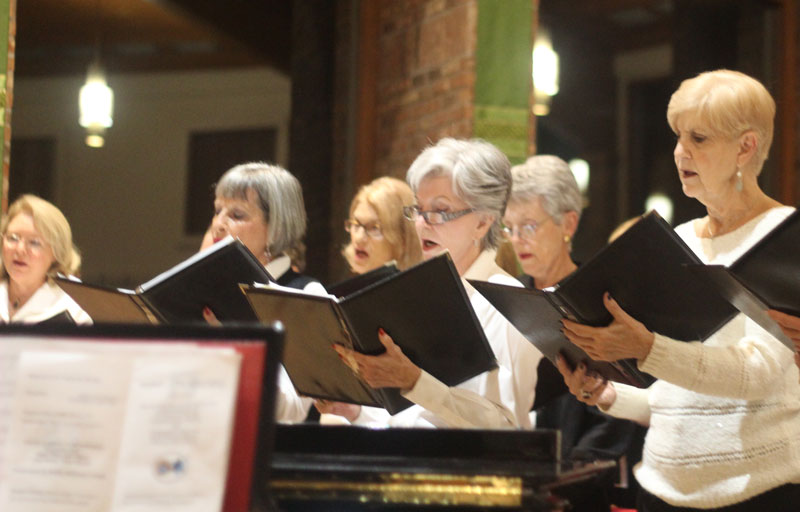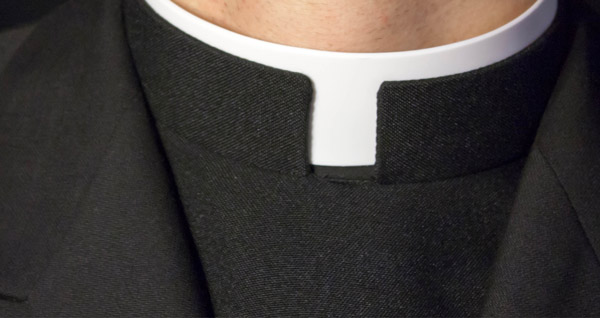
HILTON HEAD ISLAND—Rabbi Brad Bloom reminded a crowd at St. Francis by the Sea Church of a solemn anniversary dating back 79 years.
In that November of 1939, Jewish people were attacked and killed in Germany, and thousands of synagogues, Jewish-owned businesses, schools and homes were vandalized and destroyed by Nazis during a rampage of terror called Kristallnacht, “The Night of Broken Glass.”
His voice charged with emotion, Rabbi Bloom said he was proud and happy to observe the otherwise grim milestone because he was speaking to Jews and Catholics gathered for the first Interfaith Convocation by the Sea. The event was the result of more than a year of planning by members of St. Francis by the Sea and Congregation Beth Yam, the Reform synagogue that he leads.
“Tonight is about our ecumenical experience and about how far we have come in our history,” he said. “I feel so blessed to be in this country and to know we feel safe in our shared values as Jews and Christians, and that we can have events like this.”
The program offered a chance for members of both congregations to meet and get to know each other, learn about their Scriptures, traditional prayers and worship services.
For the past eight years, Rabbi Bloom has been an annual guest speaker at the Bible study at St. Francis by the Sea. In 2016, he mentioned that he would like to plan a joint event with his congregation, and the idea for the convocation took off, according to Carole McNamee, a member of St. Francis who served on the planning committee with her husband Fred McNamee.
Members of the committee met regularly for more than a year, learned more about each other’s beliefs and became friends. They discovered how much they shared, even down to the roots of their names. In Hebrew, Beth Yam means “House of the Sea.”
The keynote speaker was Rabbi Michael J. Cook, the Sol and Arlene Bronstein Professor of Judaeo- Christian Studies at Hebrew Union College-Jewish Institute of Religion in Cincinnati.
He taught Rabbi Bloom and the two later became friends. Rabbi Bloom thought Rabbi Cook would be a perfect fit for the convocation because he is an expert in the New Testament.
A morning Bible study on Nov. 9 drew 170 people from both congregations. Rabbi Cook discussed how stories from the Hebrew Bible are alluded to in the New Testament and transformed by Christian theology. Figures from Genesis such as Adam and Eve, for instance, offer perspective for New Testament teachings on sin, forgiveness and redemption.
Moses, he said, is another Old Testament figure reflected in the New Testament. While Moses led the Israelites from bondage in Egypt, his actions can be compared to Jesus, who, with his coming, led the disciples and all those who believed in him to everlasting life and a new covenant with God.
That evening, Rabbi Cook gave a talk to about 300 people on Jewish symbols in Renaissance Christian art. The evening also included music by a joint choir from St. Francis and Congregation Beth Yam, and prayers by Rabbi Bloom and Father Michael Oenbrink, pastor at St. Francis by the Sea.
Rabbi Cook focused on art depicting events central to the birth of Christ, including Gabriel’s annunciation to Mary, the traditional nativity and the journey of the magi.
He pointed out how depictions of the annunciation frequently show Mary holding a book of Scripture. Scholars believe the book is symbolically turned to the passage in Isaiah that relates to her, “Therefore the Lord himself will give you a sign;* the young woman, pregnant and about to bear a son, shall name him Emmanuel (Is 7:14).
Traditional depictions of the nativity in Renaissance art include images of the Holy Family in Bethlehem, foretold by the prophet Micah: “But you Bethlehem … least among the clans of Judah, from you shall come forth for me one who is to be ruler in Israel” (Mi 5:1).
Other images of the nativity such as the star of Bethlehem and the three kings who arrive to adore Jesus are predicted by Jewish prophets. Even animals traditionally shown in nativity scenes, the ox and the donkey, have roots in a verse of Isaiah, he said. In traditional symbolism, Rabbi Cook said, the ox is said to symbolize Jewish people who eventually came to follow Jesus, while the donkey represents gentiles who became Christians.
On Nov. 10, members of St. Francis by the Sea attended a Shabbat service at Congregation Beth Yam and heard his discussion of prophets and sages, their importance to both Christianity and Judaism.
Carole McNamee, who was raised Jewish and is now a Catholic, said the convocation was a special chance to reflect on both of the traditions and what they mean.
“This was an important, meaningful chance for us to meet with our brothers and sisters in faith, to learn more about each other and our joint sacred texts,” she said.
Miscellany/Christina Lee Knauss: Members of choirs from St. Francis by the Sea Church and Congregation Beth Yam on Hilton Head Island sing together during part of the Interfaith Convocation by the Sea on Nov. 9.



